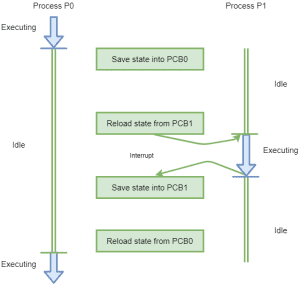1. 引言
现代操作系统能够同时运行多个程序,从而提升系统吞吐量和用户体验。这种“并发执行”的能力,是通过操作系统中的 进程(Process) 来实现的。
在本篇文章中,我们将重点介绍 进程控制块(Process Control Block, PCB),它是操作系统中用来管理进程状态和行为的核心数据结构。
2. 进程概念
进程是正在执行的程序。举个例子,我们可以写一个 Java 应用程序并保存到磁盘上,这个文件称为程序(Program),是一个静态实体。但当我们运行这个程序时,操作系统会为其创建一个 Java 进程,此时它就变成了一个动态实体。
如下图所示,是一个进程的内存布局:

图中左侧是内存区域,包括:
- Text 段:存放程序代码,从低地址开始
- 堆(Heap):动态分配内存,向上增长
- 栈(Stack):函数调用栈,向下增长
这些部分构成了进程的运行时环境。
3. 进程控制块(PCB)
PCB 是操作系统中表示进程的核心数据结构,也被称为任务控制块(Task Control Block)。它存储了与进程相关的所有关键信息。
以下是一些核心组成部分:
3.1 进程状态(Process State)
进程在其生命周期中会经历多个状态:
✅ 常见状态包括:
- New:刚被创建
- Ready:等待调度执行
- Running:正在执行
- Waiting:等待某些事件(如 I/O 完成)
- Terminated:执行完毕
状态信息帮助操作系统决定下一步如何处理该进程。
3.2 程序计数器(Program Counter)
程序计数器(PC)记录了 下一条将要执行的指令地址。这是进程切换时必须保存和恢复的重要信息。
3.3 CPU 寄存器(CPU Registers)
寄存器是 CPU 内部的小容量高速存储单元,用于保存当前进程的运行状态。包括:
- 累加器(Accumulators)
- 索引寄存器(Index Registers)
- 条件码寄存器(Condition Code)
- 通用寄存器(General Purpose Registers)
- 栈指针(Stack Pointer)
⚠️ 当中断发生时,CPU 寄存器的值会被保存到 PCB 中,以便进程恢复执行时能继续从断点执行。
3.4 其他管理信息
✅ CPU 调度信息(Scheduling Information)
- 进程优先级(Priority)
- 调度队列信息(如就绪队列)
- 调度参数(如时间片)
✅ 内存管理信息(Memory Management)
- 基址寄存器和界限寄存器(Base and Limit Registers)
- 分页表(Page Table)
- 分段表(Segment Table)
✅ 计费信息(Accounting)
- 已使用 CPU 时间
- 时间限制
- 用户账号、作业编号等
✅ I/O 状态信息(I/O Status)
- 已分配的 I/O 设备列表
- 打开的文件列表
- 等待的 I/O 操作
4. PCB 在上下文切换中的作用
PCB 是进程上下文切换(Context Switch)的关键。
上下文切换指的是:操作系统在多个进程之间切换执行的过程。这种切换通常由中断、系统调用或调度器决定。
来看一个典型的上下文切换流程:

流程说明如下:
- P0 正在运行,发生中断
- 操作系统保存 P0 的上下文(寄存器、PC 等)到其 PCB
- 操作系统加载 P1 的 PCB,恢复其上下文并开始执行
- 一段时间后,P1 也发生中断
- 操作系统保存 P1 的上下文到其 PCB
- 再次加载 P0 的 PCB,恢复执行
✅ 这一过程是多任务操作系统的基础,而 PCB 是这一机制的核心支撑。
5. 总结
本文介绍了进程控制块(PCB)的概念、结构和作用。
我们从进程的基本定义入手,逐步深入到 PCB 的组成部分,包括:
- 进程状态
- 程序计数器
- CPU 寄存器
- 调度、内存、I/O 和计费信息
最后,我们通过上下文切换的实例,说明了 PCB 在进程调度中的关键作用。
✅ PCB 是操作系统管理进程的核心结构,理解它有助于深入理解操作系统调度机制和并发控制原理。